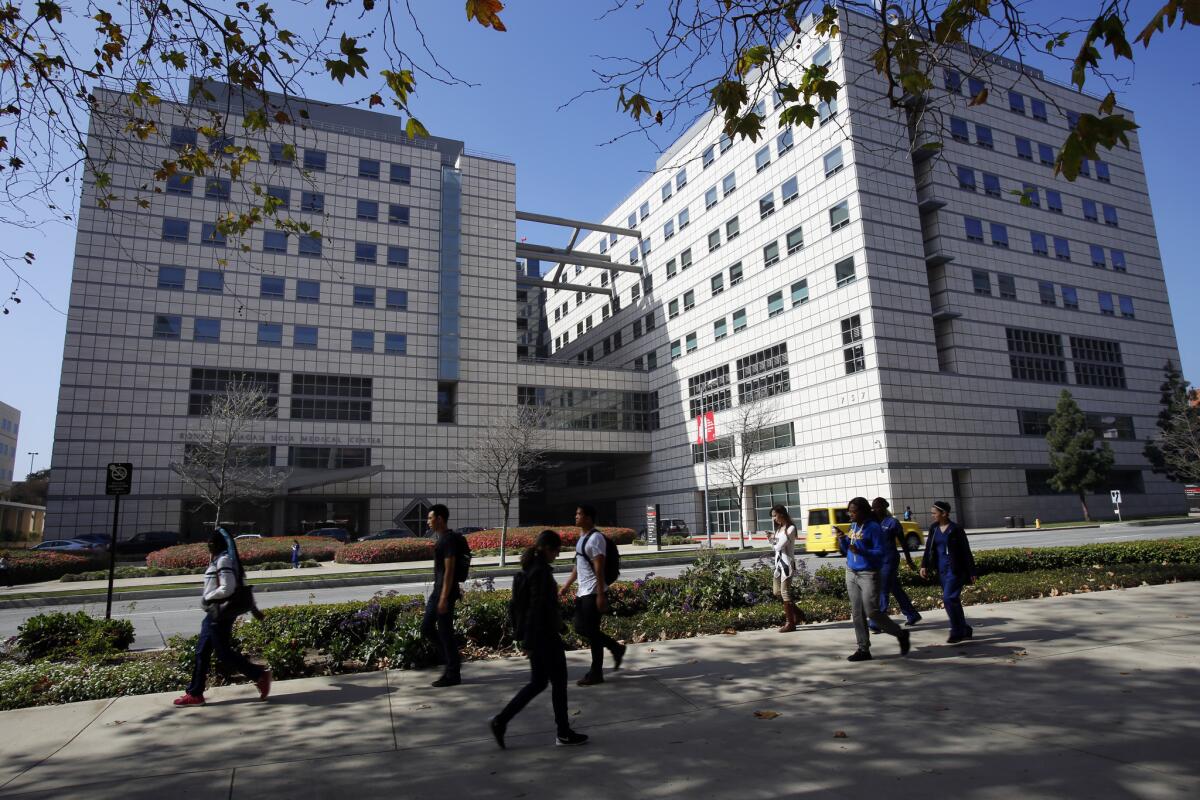Superbug linked to 2 deaths at UCLA hospital; 179 potentially exposed

Nearly 180 patients at UCLA’s Ronald Reagan Medical Center may have been exposed to potentially deadly bacteria from contaminated medical scopes, and two deaths have already been linked to the outbreak.
Update: FDA issues warning on contaminated medical scopes
The Times has learned that the two people who died are among seven patients that UCLA found were infected by the drug-resistant superbug known as CRE — a number that may grow as more patients get tested. The outbreak is the latest in a string of similar incidents across the country that has top health officials scrambling for a solution.
UCLA said it discovered the outbreak late last month while running tests on a patient. This week, it began to notify 179 other patients who were treated from October to January and offer them medical tests. By some estimates, if the infection spreads to a person’s bloodstream, the bacteria can kill 40% to 50% of patients.
At issue is a specialized endoscope inserted down the throats of about 500,000 patients annually to treat cancers, gallstones and other ailments of the digestive system.
These duodenoscopes are considered minimally invasive, and doctors credit them for saving lives through early detection and treatment. But medical experts say some scopes can be difficult to disinfect through conventional cleaning because of their design, so bacteria are transmitted from patient to patient.
These instruments are not the same type used in more routine endoscopies and colonoscopies.
The procedure in question is known as ERCP, or endoscopic retrograde cholangiopancreatography. The superbug is carbapenem-resistant Enterobacteriaceae.
UCLA said it immediately notified public health authorities after discovering the bacteria in one patient and tracing the problem to two of these endoscopes. The university said it had been cleaning the scopes “according to standards stipulated by the manufacturer,” and it changed how it disinfects the instruments after the infections occurred.
Dale Tate, a university spokeswoman, said “the two scopes involved with the infection were immediately removed and UCLA is now utilizing a decontamination process that goes above and beyond the manufacturer and national standards.”
Tate declined to provide details on the two people who died, citing patient confidentiality.
State and federal officials are looking into the situation at UCLA as they wrestle with how to respond to the problem industrywide.
Since 2012, there have been about a half-dozen outbreaks affecting up to 150 patients in Illinois, Pennsylvania and most recently at a well-known Seattle medical center, according to experts.
These outbreaks are raising questions about whether hospitals, medical-device companies and regulators are doing enough to protect patient safety. Some consumer advocates are also calling for greater disclosure to patients of the increased risks for infection before undergoing these procedures.
Lawrence Muscarella, a hospital-safety consultant and expert on endoscopes in Montgomeryville, Pa., said the recent number of cases is unprecedented.
“These outbreaks at UCLA and other hospitals could collectively be the most significant instance of disease transmission ever linked to a contaminated reusable medical instrument,” he said.
Officials at the U.S. Centers for Disease Control and Prevention said they were assisting the L.A. County Department of Public Health in its investigation of the UCLA infections.
Dr. Alex Kallen, an epidemiologist in CDC’s Division of Healthcare Quality Promotion, said the outbreaks are serious given how difficult this superbug can be to treat and the fact that additional cases might be going undetected.
“This bacteria is emerging in the U.S. and it’s associated with a high mortality rate,” Kallen said in an interview. “We don’t want this circulating anywhere in the community.”
Last month, Virginia Mason Medical Center in Seattle acknowledged that 32 patients were sickened by contaminated endoscopes from 2012 to 2014 with a bacterial strain similar to CRE. Eleven of those patients died.
But Virginia Mason said other factors may have contributed to their deaths because many of them were already critically ill.
The duodenoscopes typically involved in the outbreaks have an “elevator channel” that doctors use to bend the device in tight spaces and allow for attachments such as catheters or guide wires. Experts suspect bacteria build up in that small area.
Kallen, the CDC official, said he hasn’t found any breaches in cleaning protocol at hospital outbreaks he has investigated, but he said the problem probably is more complicated than just a design issue.
“There isn’t an obviously easy solution to employ,” Kallen said. “There is action on a lot of different fronts.”
Virginia Mason instituted a new quarantine process that sets the endoscopes aside for 48 hours so evidence of any bacterial growth can be found before reusing them.
That has increased the time for equipment cleaning from a couple of hours to more than two days. Virginia Mason said it had to purchase 20 additional endoscopes to compensate for that down time.
“There is either a design issue to be addressed or a change to the guidelines for the cleaning process,” said Dr. Andrew Ross, section chief of gastroenterology at Virginia Mason. “It’s the role of the federal government to make some of those decisions.”
In the wake of the Seattle cases, Sen. Patty Murray (D-Washington) pressed the FDA to issue guidelines for hospitals on how best to sanitize these scopes and devise a way to better track infections.
Some patient-safety advocates say regulators and industry officials have been too slow to respond.
“Hospitals and manufacturers often take months to assess what to do, with the infected patients being the last to know,” Muscarella said. “Bringing patients into the loop and answering their questions is important for hospitals to prevent outbreaks.”
A spokeswoman for the FDA said the agency was working to reduce the incidence of infections while maintaining access to a crucial medical tool.
The agency said it was “actively engaged with the manufacturers of duodenoscopes used in the U.S. and with other government agencies such as the CDC to develop solutions to minimize patient risk associated with these issues.… The FDA believes the continued availability of these devices is in the best interest of the public health.”
Olympus Medical Systems Group, a major manufacturer of these endoscopes and UCLA’s supplier, said it was working with the FDA, physician groups and hospitals regarding these safety concerns.
The company said all of its customers who purchase Olympus duodenoscopes “receive instruction and documentation to pay careful attention to cleaning.”
UCLA said it moved quickly to protect patients once the problem surfaced. It said it alerted state and county health officials as soon as the bacteria were detected.
It is notifying 179 patients and their primary-care doctors by phone and letter. UCLA said it was offering to send patients a free home testing kit for a rectal swab, or they could come in to be tested.
Even before this incident, UCLA has struggled at times with patient safety. An influential healthcare quality organization gave the Ronald Reagan Medical Center a failing grade on patient safety in 2012.
The hospital’s score improved to a C in the latest ratings from Leapfrog Group, a Washington nonprofit backed by large employers and leading medical experts.
Meanwhile, some doctors worry the outbreaks might deter patients from seeking care they need.
“ERCP is a common and critical procedure in most hospitals today,” said Dr. Bret Petersen, a professor of medicine at Mayo Clinic’s division of gastroenterology and hepatology in Rochester, Minn. “It’s not a procedure we can allow to be constrained, so this is a serious issue we need to address.”
Q&A: What makes CRE superbugs so dangerous?
How safe is your hospital? A look at California ratings
Let us know if you have been affected by the outbreak at UCLA
Twitter: @chadterhune
More to Read
Inside the business of entertainment
The Wide Shot brings you news, analysis and insights on everything from streaming wars to production — and what it all means for the future.
You may occasionally receive promotional content from the Los Angeles Times.











